
The Battle of Gettysburg was a three-day battle in the American Civil War fought between Union and Confederate forces between July 1 and July 3, 1863, in and around Gettysburg, Pennsylvania. The battle, which was won by the Union, is widely considered the Civil War's turning point, ending the Confederacy's aspirations to establish an independent nation. It was the Civil War's bloodiest battle, claiming over 50,000 combined casualties over three days. Union Major General George Meade's Army of the Potomac defeated attacks by Confederate General Robert E. Lee's Army of Northern Virginia, halting Lee's invasion of the North and forcing his retreat.

Joshua Lawrence Chamberlain was an American college professor and politician from Maine who volunteered during the American Civil War to join the Union Army. He became a highly respected and decorated Union officer, reaching the rank of brigadier general. He is best known for his gallantry at the Battle of Gettysburg, leading a bayonet charge, for which he was awarded the Medal of Honor.

The 20th Maine Infantry Regiment was a volunteer regiment of the United States Army during the American Civil War (1861–1865), most famous for its defense of Little Round Top at the Battle of Gettysburg in Gettysburg, Pennsylvania, July 1–3, 1863. The 133rd Engineer Battalion of the Maine Army National Guard and the United States Army today carries on the lineage and traditions of the 20th Maine.

Strong Vincent was a lawyer who became famous as a U.S. Army officer during the American Civil War. He was mortally wounded while leading his brigade during the fighting at Little Round Top on the second day of the Battle of Gettysburg, and died five days later.

Little Round Top is the smaller of two rocky hills south of Gettysburg, Pennsylvania—the companion to the adjacent, taller hill named Big Round Top. It was the site of an unsuccessful assault by Confederate troops against the Union left flank on July 2, 1863, the second day of the Battle of Gettysburg, during the American Civil War.

During the second day of the Battle of Gettysburg Confederate Gen. Robert E. Lee attempted to capitalize on his first day's accomplishments. His Army of Northern Virginia launched multiple attacks on the flanks of the Union Army of the Potomac, commanded by Maj. Gen. George G. Meade. The assaults were unsuccessful, and resulted in heavy casualties for both sides.

Holman Staples Melcher was an American military officer, businessman, and politician active during the Reconstruction Era. A faction of historians and soldiers controversially contend that he led the downhill bayonet charge of Little Round Top during the Battle of Gettysburg. Aside from his feats during the American Civil War, he served two one-year terms as the Mayor of Portland, Maine, from 1889 to 1890.
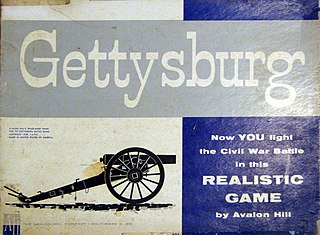
Gettysburg is a board wargame produced by Avalon Hill in 1958 that re-enacts the American Civil War battle of Gettysburg. The game rules were groundbreaking in several respects, and the game, revised several times, was a bestseller for Avalon Hill for several decades.
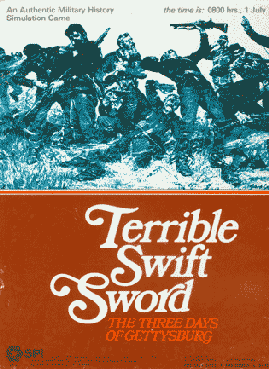
Terrible Swift Sword: Battle of Gettysburg Game is a grand tactical regimental level board wargame published by Simulations Publications, Inc. (SPI) in 1976 that simulates the Battle of Gettysburg during the American Civil War. A second edition was published by TSR in 1986.
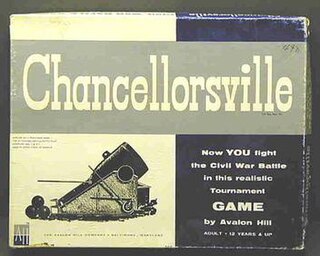
Chancellorsville is a board wargame produced by Avalon Hill in 1961, and republished in 1974 that simulates the Battle of Chancellorsville during the American Civil War.
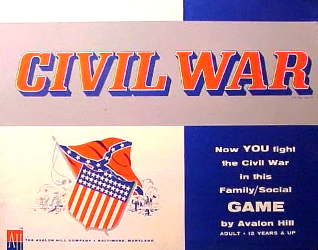
Civil War is an early strategic board wargame published by Avalon Hill in 1961 that simulates the American Civil War. Unlike other games produced by Avalon Hill during this period such as Gettysburg, Civil War did not sell well and was dropped from production two years later.
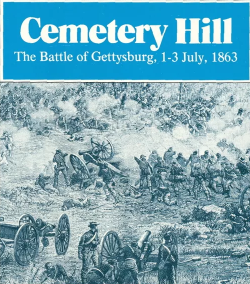
Cemetery Hill, subtitled "The Battle of Gettysburg, 1–3 July 1863", is a board wargame published by Simulations Publications, Inc. (SPI) in 1975 as part of the "quadrigame" Blue & Gray: Four American Civil War Battles that simulated four battles of the American Civil War. Cemetery Hill was later released as a stand-alone "folio" game.

Devil's Den, subtitled "Hood's Assault at Gettysburg", is a board game published by Operational Studies Group (OSG) in 1980 that simulates the fighting to control the key Devil's Den terrain feature during the 1863 Battle of Gettysburg during the American Civil War.

The 17th Maine Infantry Regiment was an infantry regiment that served in the Union Army during the American Civil War. It was particularly noted for its service during the 1863 Battle of Gettysburg.

The 15th Alabama Infantry Regiment was a Confederate volunteer infantry unit from the state of Alabama during the American Civil War. Recruited from six counties in the southeastern part of the state, it fought mostly with Robert E. Lee's Army of Northern Virginia, though it also saw brief service with Braxton Bragg and the Army of Tennessee in late 1863 before returning to Virginia in early 1864 for the duration of the war. Out of 1,958 men listed on the regimental rolls throughout the conflict, 261 are known to have fallen in battle, with sources listing an additional 416 deaths due to disease. 218 were captured, 66 deserted and 61 were transferred or discharged. By the end of the war, only 170 men remained to be paroled.

Walter Goodale Morrill was a Union Army officer in the American Civil War and a recipient of the U.S. military's highest decoration, the Medal of Honor, for his actions at the Second Battle of Rappahannock Station in November 1863. Also, Morrill's earlier actions in July 1863 at Gettysburg are considered essential for the famous Union victory on Little Round Top.
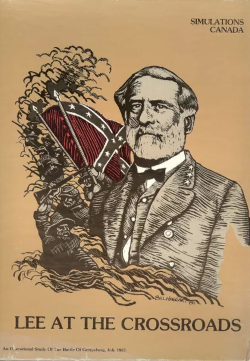
Lee at the Crossroads is a board wargame published by Simulations Canada (SimCan) in 1980 that simulates the 1863 Battle of Gettysburg during the American Civil War. Each player takes the role of one of the opposing commanders, Confederate general Robert E. Lee or Union general George Meade.

Pickett's Charge, subtitled "A Game of the Battle of Gettysburg, July 1–3, 1863", is a board wargame published by Yaquinto Publications in 1980 that is a tactical simulation of the three-day Battle of Gettysburg.
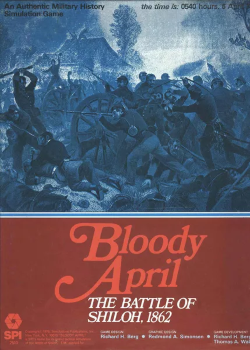
Bloody April: The Battle of Shiloh, 1862 is a board wargame published by Simulations Publications Inc. (SPI) in 1979 that simulates the Battle of Shiloh during the American Civil War. A revised edition published in 2022 by GMT Games became the 8th installment of the ongoing "Great Battles of the American Civil War" series.
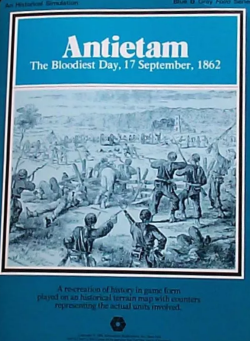
Antietam: The Bloodiest Day, 17 September 1862 is a board wargame published by Simulations Publications, Inc. (SPI) in 1975 that simulates the Battle of Antietam during the American Civil War. The game was originally part of the four-game collection Blue & Gray: Four American Civil War Battles, and was also released as a stand-alone "folio" game. It proved to be one of SPI's most popular games in the year following its publication.




















